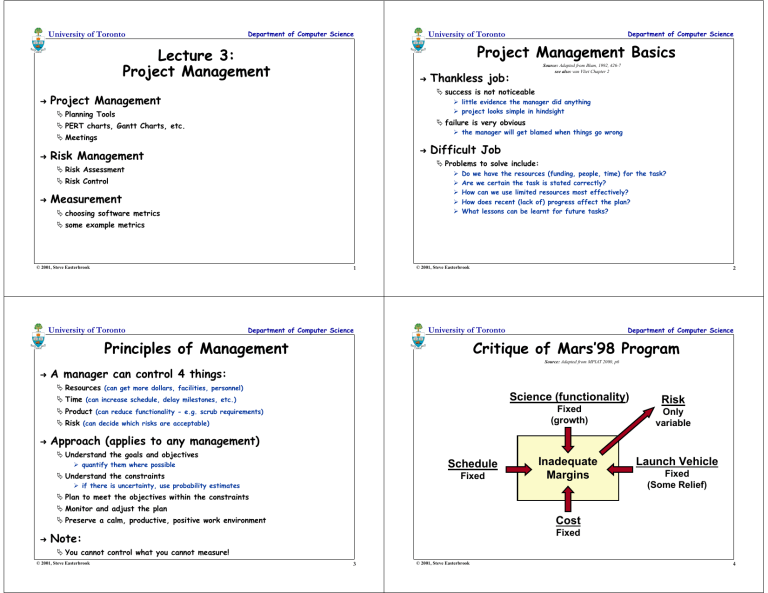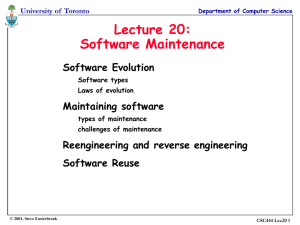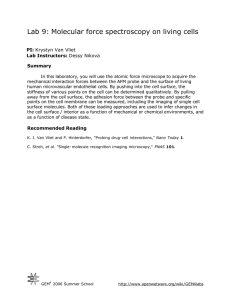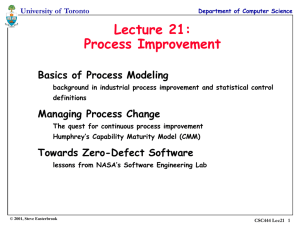Project Management Basics Lecture 3: Project Management Thankless job:
advertisement

University of Toronto Department of Computer Science Project Management Basics Lecture 3: Project Management ➜ ➜ Thankless job: little evidence the manager did anything project looks simple in hindsight failure is very obvious PERT charts, Gantt Charts, etc. the manager will get blamed when things go wrong Meetings ➜ Risk Management Difficult Job Problems to solve include: Risk Assessment Risk Control ➜ Source: Adapted from Blum, 1992, 426-7 see also: van Vliet Chapter 2 success is not noticeable Project Management Planning Tools ➜ Department of Computer Science University of Toronto Measurement choosing software metrics Do we have the resources (funding, people, time) for the task? Are we certain the task is stated correctly? How can we use limited resources most effectively? How does recent (lack of) progress affect the plan? What lessons can be learnt for future tasks? some example metrics © 2001, Steve Easterbrook 1 University of Toronto Department of Computer Science © 2001, Steve Easterbrook 2 Department of Computer Science University of Toronto Principles of Management Critique of Mars’98 Program Source: Adapted from MPIAT 2000, p6 ➜ A manager can control 4 things: Resources (can get more dollars, facilities, personnel) Science (functionality) Time (can increase schedule, delay milestones, etc.) Fixed (growth) Product (can reduce functionality - e.g. scrub requirements) Risk (can decide which risks are acceptable) ➜ Risk Only variable Approach (applies to any management) Understand the goals and objectives Schedule quantify them where possible Understand the constraints Fixed if there is uncertainty, use probability estimates Inadequate Margins Launch Vehicle Fixed (Some Relief) Plan to meet the objectives within the constraints Monitor and adjust the plan Cost Preserve a calm, productive, positive work environment ➜ Fixed Note: You cannot control what you cannot measure! © 2001, Steve Easterbrook 3 © 2001, Steve Easterbrook 4 Department of Computer Science University of Toronto Tool 1: Work Breakdown Structure Tool 2: PERT charts Source: Adapted from Blum, 1992, p438 see also: van Vliet pp192-3 1.1 Software Systems Engineering 1.1.1 1.1.2 1.1.3 1.1.4 1.1.5 1.1.6 1.1.7 Support to Systems Engineering Support to Hardware Engineering Software Engineering Trade Studies System Requirements Analysis Software Requirements Analysis Interface Analysis Support to Systems Test 1.2 Software Development 1.2.1 Deliverable Software 1.2.1.1 Requirements Analysis 1.2.1.2 Architectural Design 1.2.1.3 Procedural Design 1.2.1.4 Code 1.2.1.5 Unit Test 1.2.1.6 Software Integration Test 1.2.1.7 Technical Reviews 1.2.1.8 Technical Training 1.2.2 Non-deliverable Software 1.2.3 Purchased Software 1.2.3.1 Package Evaluation 1.2.4 Development facilities and tools Source: Adapted from Blum, 1992, p439 see also: van Vliet pp193-6 1.3 Software Test and Evaluation 1.3.1 1.3.2 1.3.3 1.3.4 Software Dev. Test & Evaluation End-Product Acceptance Test Test Bed & Tool Support Test Data Management 2 ➜ Configuration Management Library Operations Interface Control Data Management Quality Assurance Quality Control ➜ te=9 Shows Critical Path 6 Department of Computer Science University of Toronto Tool 4: Meetings Source: Adapted from Pfleeger, 1998, 92 Sept Oct Nov Dec Jan 6 1320273 101724317 1421284 1118251 8 1522 ➜ Meetings are expensive E.g. 8 people on $40k. Meeting costs $320 per hour ➜ Meetings are necessary Can save money by averting misunderstandings and coordination errors ➜ Time wasters: Purpose of meeting unclear Attendees unprepared Essential people missing Bars show duration of tasks Triangles show milestones Vertical dashed lines show dependencies ➜ te=7 9 te=7 Notation see also: van Vliet pp195-6 Notation Discussion gets sidetracked Dominance by one or two people argumentative Shows high level view of whole project © 2001, Steve Easterbrook 4 6 © 2001, Steve Easterbrook Department of Computer Science 1.2 Software Development 1.2.1 Requirements Analysis 1.2.2 Architectural Design 1.2.3 Procedural Design 1.2.4 Code 1.3 Testing 1.3.1 Unit Test 1.3.2 Integration Test 1.3.3 Acceptance Test 1.4 Operations 1.4.1 Packaging 1.4.2 Customer Training ➜ te=0 te=6 10 te=1 Longest path from start to finish any slippage on the critical path will cause project delay ... Tool 3: Gantt Charts 7 Nodes indicate milestones Edges indicate dependencies Edges are labelled with time to complete 5 Task te=9 3 te=4 1.6 Operations and Support University of Toronto 8 te=3 te=11 0 Project Management Administrative Support Management Tools Management Reviews Management Training © 2001, Steve Easterbrook te=4 5 te=6 1.5 Product Assurance 1.5.1 1.5.2 1.5.3 1.5.4 1.5.5 1.5.6 te=2 1 1.4 Management 1.4.1 1.4.2 1.4.3 1.4.4 1.4.5 Department of Computer Science University of Toronto Decisions not followed up on 7 © 2001, Steve Easterbrook Meetings Meetings advice: advice: Announce Announce details details inin advance advance who whoshould shouldattend attend start startand andend endtimes times goals goalsof ofmeeting meeting Written Written agenda, agenda, distributed distributed inin advance advance Identify Identify aa chairperson chairperson who: who: keeps keepsthe thediscussion discussionon ontrack track resolves resolvesarguments arguments Identify Identify aa secretary secretary who: who: keeps keepstrack trackof ofdecisions decisionstaken taken records action items records action items ensures ensuresaction actionitems itemsare arecarried carried out out Associate Associate aa responsible responsible person person with each action with each action item item 8 Department of Computer Science University of Toronto Risk Management ➜ Two Parts: Top Ten Risks (with Countermeasures) Source: Adapted from Blum, 1992, p441-447 see also: van Vliet pp189-191 Unrealistic schedules and budgets Definitions multisource estimation designing to cost requirements scrubbing Risk Exposure (RE) = p(unsat. outcome) X loss(unsat. outcome) Risk Reduction Leverage (RRL) = (REbefore - REafter) / cost of intervention Principles better requirements analysis organizational/operational analysis Developing the wrong User Interface Risk prevention is cheaper than risk detection Degree and Cause of Risk must never be hidden from decision makers prototypes, scenarios, task analysis Gold Plating “The real professional … knows the risks, their degree, their causes, and the action necessary to counter them, and shares this knowledge with [her] colleagues and clients” (Tom Gilb) © 2001, Steve Easterbrook requirements scrubbing cost benefit analysis designing to cost 9 Department of Computer Science University of Toronto pre-award audits competitive designs Real-time performance shortfalls targeted analysis simulations, benchmarks, models Straining computer science capabilities technical analysis checking scientific literature 10 Department of Computer Science Some suggested metrics Source: Adapted from Nusenoff & Bunde, 1993 “You Cannot Control What You Cannot Measure” Plot planned and actual staffing levels over time Types of Metric Record number & type of code and test errors Plot number of resolved & unresolved problem reports over time algorithmic vs. subjective process vs. product Plot planned & actual number of units whose V&V is completed over time: a) design reviews completed b) unit tests completed c) integration tests completed Good metrics are: simple (to collect and interpret) valid (measure what they purport to measure) robust (insensitive to manipulation) prescriptive analyzable Plot software build size over time Plot average complexity for the 10% most complex units over time (using some suitable measure of complexity) Plot new, modified and reused SLOCs for each CSCI over time 5 types of scale SLOC = Source Lines Of Code (decide how to count this!) Plot estimated schedule to completion based on deliveries achieved nominal (=, ≠ make sense; discrete categories) ordinal (<, >, =, make sense; e.g. oven temps: cool, warm, hot, very hot) interval (+, -, <, >, = make sense; e.g. temperature in centigrade) ratio (x, ÷, +, -, <, >, = make sense; e.g. temperature in Kelvin) absolute (a natural number count) © 2001, Steve Easterbrook Shortfalls in externally performed tasks University of Toronto Source: Adapted from Blum, 1992, p457-458 see also: van Vliet pp104-9 ➜ early benchmarking inspections, compatibility analysis © 2001, Steve Easterbrook Principles of Measurement ➜ high change threshold information hiding incremental development Shortfalls in externally furnished components Developing the wrong Software functions If you don’t actively attack risks, they will attack you ➜ Continuing stream of requirements changes use top talent team building training Risk Control ➜ Source: Adapted from Boehm, 1989 see also: van Vliet p192 Personnel Shortfalls Risk Assessment ➜ Department of Computer Science University of Toronto (needs a detailed WBS and PERT or GANTT chart) 11 © 2001, Steve Easterbrook 12 Department of Computer Science University of Toronto References Summary ➜ Project management is difficult ➜ First Plan the project van Vliet, H. “Software Engineering: Principles and Practice (2nd Edition)” Wiley, 1999. van Vliet organizes this material differently from the way it is presented here, and provides a lot more detail on some aspects (especially people management and cost estimation). Chapter 2 provides a brief but excellent intro. Chapters 5, 6 and 8 are definitely worth reading at this stage in the course. Requires Work Breakdown Structure Requires cost and effort data ➜ Blum, B. “Software Engineering: A Holistic View”. Oxford University Press, 1992. Then identify risks Identify risk mitigation strategies Pfleeger, S. “Software Engineering: Theory and Practice”. Prentice Hall, 1997. Try for risk prevention ➜ Department of Computer Science University of Toronto Nusenoff, R. and Bunde, D. “A Guidebook and a Spreadsheet Tool for a Corporate Metrics Program”. Journal of Systems and Software, Vol 23, pp245-255, 1993. Keep Measuring Progress Choose metrics that help track progress towards goals Choose metrics that give early warning about risks Boehm, B. “Software Risk Management”. IEEE Computer Society Press. 1989. MPIAT - Mars Program Independent Assessment Team Summary Report, NASA JPL, March 14, 2000. (available at http://www.nasa.gov/newsinfo/marsreports.html) © 2001, Steve Easterbrook 13 © 2001, Steve Easterbrook 14



